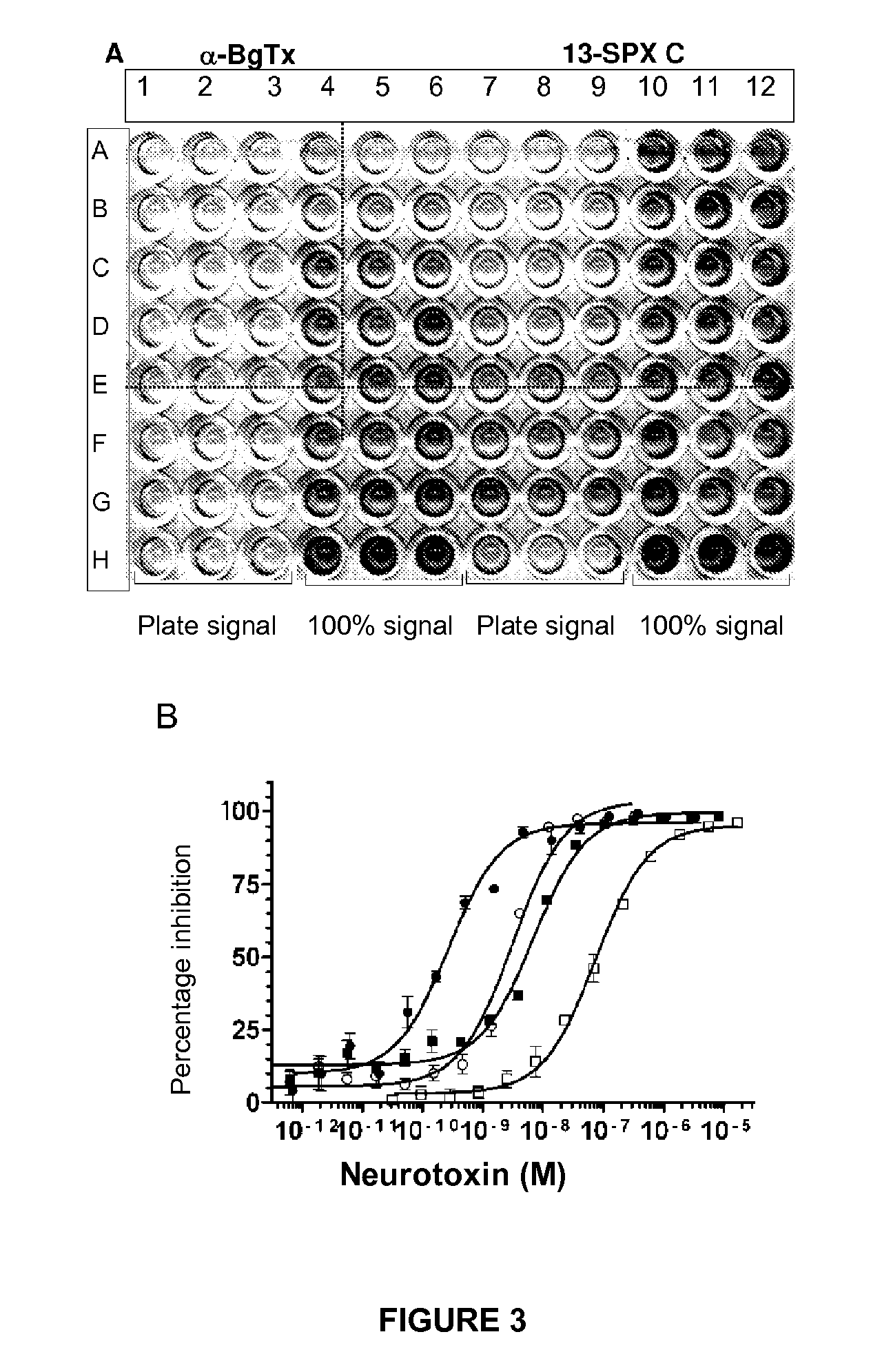Method for manufacturing an analysis substrate, and use thereof for detecting toxins
a technology of substrates and analysis, applied in the field of seafood monitoring, can solve the problems of difficult testing, large infrastructure requirements, and danger to the marine ecosystem, and achieve the effects of reducing the risk of contamination, and reducing the detection efficiency of toxins
- Summary
- Abstract
- Description
- Claims
- Application Information
AI Technical Summary
Benefits of technology
Problems solved by technology
Method used
Image
Examples
example 1
Method for Detecting the Interaction Between Nicotinic Acetylcholine Receptors (nAChRs) and Toxins
Products Used
[0097]In the example below, the products and devices used were the following:
[0098]The flat-bottomed Maxisorp ELISA plates were purchased from the company Nunc (Kamstrupvej, Denmark).
[0099]The coating buffer was the following: tris buffered saline (TBS) (150 mM sodium chloride, 50 mM Tris-HCl, pH 7.5).
[0100]Washing buffer: TBS containing 0.1% Tween 20.
[0101]Blocking buffer: TBS containing 0.5% bovine serum albumin (BSA).
[0102]A 10-times concentrated TBS buffer stock solution at pH 7 was prepared and was autoclaved and stored at ambient temperature, namely 25° C., for preparing said buffers.
[0103]The biotinylated α-bungarotoxin (biotin-α-BgTx) was purchased from the company Molecular Probes (Eugene, Oreg., USA).
[0104]The Complete Protease Inhibitor mix was purchased from the company Roche Diagnostics GmbH, Mannheim, Germany. The bovine serum albumin (BSA) came from the compa...
example 2
Method for Detecting 13-Desmethyl Spirolide C, 13,19-Didesmethyl Spirolide C and Gymnodimine A from Seafood Extracts and Anatoxin-A from Cyanobacterial Extracts
[0132]In this example, the following solutions and protocols were used:[0133]Coating buffer: TBS (150 mM sodium chloride, 50 mM Tris-HCl, pH 7.5).[0134]Dilution of membranes: 200-fold. A volume of 50 μl of Torpedo membrane (2.7 mg·ml−1 of protein in 5 mM of glycine) was diluted in 10 ml of TBS.[0135]Support: Maxisorp flat-bottomed ELISA plates (Nunc).[0136]Coating volume: 100 μl of Torpedo membranes diluted 200-fold.[0137]Coating temperature and time: ambient temperature (25° C.) for 2 hours or 4° C. overnight.[0138]Control seafood (Queen scallops, oysters, mussels and scallops) extracts and seafood (Queen scallops, oysters, mussels and scallops) extracts doped with 13-desmethyl spirolide C, 13,19-didesmethyl spirolide C and gymnodimine A.[0139]Extracts of cyanobacteria producing anatoxin-a and homoanatoxin-a.
[0140]A Maxisorp...
example 3
High-Throughput Screening of Nicotinic Acetylcholine Receptor Competitive Ligands / Toxins
[0162]The microplates coated with Torpedo electrocyte membranes which are stored at 4° C., obtained in Example 1, are suitable for high-throughput methods.
A / Use of the Liquidator 96™ 96-Tip Manual Pipetting Device (Rainin):
a) 96-Tube Plates to be Prepared Before Beginning the Detection Method:
[0163]A plate plan is prepared beforehand as represented in FIG. 5 B: seven extracts of environmental cyanobacteria tested in triplicate at three dilutions (10-, 100- and 1000-fold) and serial dilutions of 13,19-didesmethyl spirolide C ranging from 5×10−7 to 5×10−13 M, in addition to the negative controls (control plate, 3 wells), and 100% signal (6 wells) and 100% inhibition (1×10−5 M BgTx, 3 wells) controls, were tested using the method.
[0164]The plate of FIG. 6 C shows in rectangles the distribution of the seven marine cyanobacterial extracts and of the 13,19-didesmethyl spirolide C.
Rectangle I [A1-C3], ...
PUM
 Login to View More
Login to View More Abstract
Description
Claims
Application Information
 Login to View More
Login to View More - R&D
- Intellectual Property
- Life Sciences
- Materials
- Tech Scout
- Unparalleled Data Quality
- Higher Quality Content
- 60% Fewer Hallucinations
Browse by: Latest US Patents, China's latest patents, Technical Efficacy Thesaurus, Application Domain, Technology Topic, Popular Technical Reports.
© 2025 PatSnap. All rights reserved.Legal|Privacy policy|Modern Slavery Act Transparency Statement|Sitemap|About US| Contact US: help@patsnap.com



